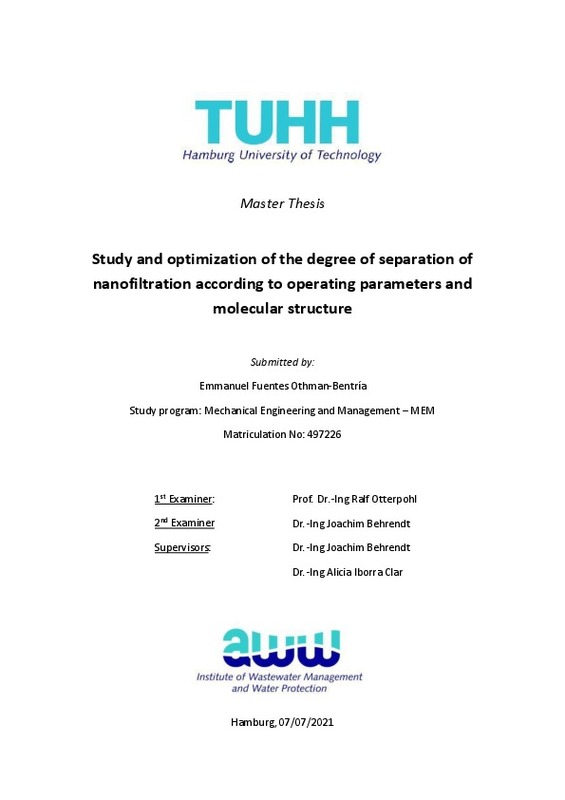JavaScript is disabled for your browser. Some features of this site may not work without it.
Buscar en RiuNet
Listar
Mi cuenta
Estadísticas
Ayuda RiuNet
Admin. UPV
Estudio y optimización del grado de separación de la nanofiltración en función de los parámetros operativos y la estructura molecular
Mostrar el registro sencillo del ítem
Ficheros en el ítem
| dc.contributor.advisor | Iborra Clar, Alicia
|
es_ES |
| dc.contributor.author | Fuentes Othman-Bentría, Emmanuel
|
es_ES |
| dc.date.accessioned | 2021-09-22T14:02:51Z | |
| dc.date.available | 2021-09-22T14:02:51Z | |
| dc.date.created | 2021-09-06 | |
| dc.date.issued | 2021-09-22 | es_ES |
| dc.identifier.uri | http://hdl.handle.net/10251/173106 | |
| dc.description.abstract | [ES] Dado que la contaminación del agua supone un gran problema en la actualidad, se estudiará la posibilidad de eliminar ciertos componentes de las corrientes de aguas residuales con la técnica de nanofiltración. Se estudiará la eliminación de tres componentes: azul de metileno, brilliant green y acid orange 7. . Se investigará la influencia de diversos parámetros en la membrana, tales como el caudal al que circula el agua, la presión, etc. | es_ES |
| dc.description.abstract | [EN] Water pollution is one of the main problems for the human health and for the environment nowadays. This contamination, which has different sources, such as industries, hospitals, households, etc., needs to be erased from the effluents in order to reuse this water for the living beings, as well as for the nature in general. In this Master Thesis the possibility of erase dyes from the water is studied. The dyes studied are Methylene Blue (MB), Brilliant Green (BG) and Acid Orange 7 (AO7). These dyes are widely used in the textile industry, as well as in other fields such as the pharmacy, plastic, or cosmetic industries. To eliminate these dyes, a nanofiltration membrane has been used. This wastewater treatment method has several advantages, such as its ability to remove any dye, its high efficiency, and its reasonable overall cost. In order to evaluate the membrane efficiency in removing these dyes, the influence of the feed pressure or the feed flow has been studied, as well as some parameters like the recovery ratio, which can describe the membrane performance. The experimental results shows that this method can eliminate in a great way these dyes that have been studied, showing rejection factors around 90% in the case of MB and around 99% in the case of the other two dyes (BG and AO7). | es_ES |
| dc.format.extent | 94 | es_ES |
| dc.language | Inglés | es_ES |
| dc.publisher | Universitat Politècnica de València | es_ES |
| dc.rights | Reserva de todos los derechos | es_ES |
| dc.subject | Nanofiltración | es_ES |
| dc.subject | Membrana | es_ES |
| dc.subject | Azul de metileno | es_ES |
| dc.subject | Brilliant green | es_ES |
| dc.subject | Acid orange 7 | es_ES |
| dc.subject | Aguas residuales | es_ES |
| dc.subject.classification | INGENIERIA QUIMICA | es_ES |
| dc.subject.other | Máster Universitario en Ingeniería Industrial (Acceso desde Grado I. Química)-Màster Universitari en Enginyeria Industrial (Accés des de Grau I. Química) | es_ES |
| dc.title | Estudio y optimización del grado de separación de la nanofiltración en función de los parámetros operativos y la estructura molecular | es_ES |
| dc.type | Tesis de máster | es_ES |
| dc.rights.accessRights | Abierto | es_ES |
| dc.contributor.affiliation | Universitat Politècnica de València. Departamento de Ingeniería Química y Nuclear - Departament d'Enginyeria Química i Nuclear | es_ES |
| dc.contributor.affiliation | Universitat Politècnica de València. Escuela Técnica Superior de Ingenieros Industriales - Escola Tècnica Superior d'Enginyers Industrials | es_ES |
| dc.description.bibliographicCitation | Fuentes Othman-Bentría, E. (2021). Estudio y optimización del grado de separación de la nanofiltración en función de los parámetros operativos y la estructura molecular. Universitat Politècnica de València. http://hdl.handle.net/10251/173106 | es_ES |
| dc.description.accrualMethod | TFGM | es_ES |
| dc.relation.pasarela | TFGM\141046 | es_ES |
Este ítem aparece en la(s) siguiente(s) colección(ones)
-
ETSII - Trabajos académicos [9940]
Escuela Técnica Superior de Ingenieros Industriales






